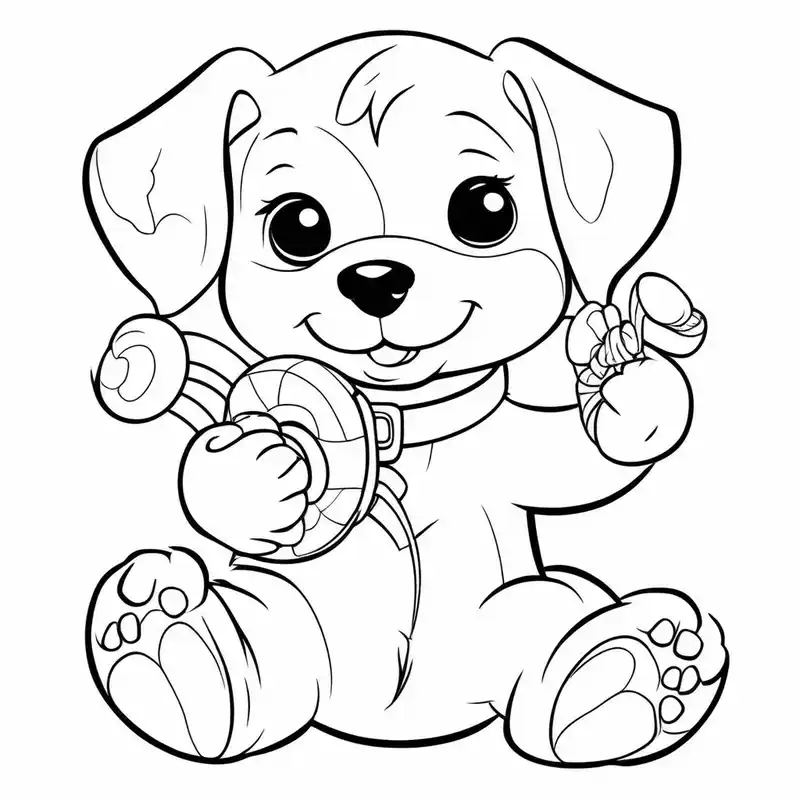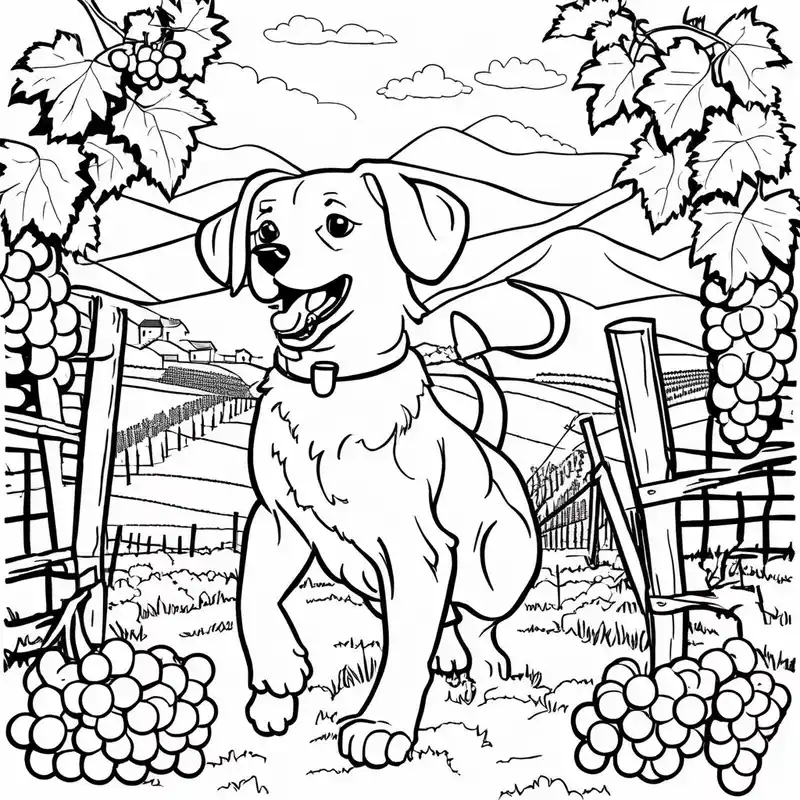64 Free Dog Coloring Pages
As both a wildlife ornithologist and manager of a canine sanctuary, I’ve spent decades observing the intricate behaviors of animals—from migratory birds to rescued dogs. Today, I’m thrilled to bridge these worlds by introducing 64 Free Dog Coloring Pages, a collection designed to celebrate the beauty of Canis familiaris while honing artistic observation skills. Whether you’re an educator, a parent, or a fellow animal enthusiast, these pages offer more than just creative fun—they’re a gateway to understanding one of humanity’s oldest companions.

Playful Puppy

Dog in a Basket

Happy Dog with a Bone
The Art and Science of Dog Coloring Pages
Coloring has long been a tool for fostering mindfulness and fine motor skills, but dog-themed pages add a layer of biological intrigue. Each illustration in this collection—from spirited huskies to serene greyhounds—invites colorists to study the anatomical nuances that define breeds. Notice the muscular build of a boxer, the wiry coat of a terrier, or the expressive eyes of a border collie. These details aren’t just artistic flourishes; they reflect centuries of selective breeding and adaptation. By shading a German shepherd’s dense fur or a dachshund’s elongated frame, artists subconsciously absorb the physical traits that make each breed unique—a skill invaluable to wildlife photographers and sanctuary caregivers alike.
For sanctuary managers, recognizing these traits is critical. A dog’s posture, ear position, or tail carriage can reveal its emotional state, a lesson subtly reinforced through mindful coloring. Meanwhile, the free PDF format ensures accessibility, allowing educators to print high-resolution pages for classrooms or therapy sessions.
Puppy and Butterflies Dog with a Frisbee Sleeping Puppy


Dogs: A Keystone Species in Human History
Domestic dogs have shared our lives for over 14,000 years, evolving from wolves into protectors, herders, and healers. At our sanctuary, we witness daily how dogs bridge gaps in human empathy—whether comforting trauma survivors or aiding those with disabilities. Their roles are as diverse as their genetics, a theme echoed in these coloring sheets. Pages depicting working breeds like retrievers or huskies nod to their historical jobs, while illustrations of mixed-breed rescue dogs highlight the beauty of genetic diversity.
Biologically, dogs are marvels of adaptation. Their olfactory cortex—40 times larger than ours—powers scent-tracking abilities, while their social intelligence rivals that of primates. Coloring a beagle’s floppy ears or a corgi’s sturdy legs isn’t just artistic play; it’s an homage to the evolutionary craftsmanship that lets these animals thrive in roles as varied as search-and-rescue or emotional support.
Dog with a Tennis Ball Dog in a Paw Print Dog in a Hat Puppy with a Toy Dog Running Dog and Balloons





Cultivating Drawing Skills Through Canine Anatomy
For aspiring artists, dogs are ideal subjects to master texture, proportion, and movement. A golden retriever’s flowing coat demands layered pencil strokes, while a bulldog’s wrinkles require careful shadowing. In my fieldwork, sketching animals sharpens observational precision—a skill directly transferable to coloring.
Here are three techniques to elevate your dog-drawing prowess:
- Fur Realism: Use short, directional strokes for short-haired breeds (e.g., boxers) and wispy, overlapping lines for fluffier coats (e.g., Samoyeds).
- Dynamic Postures: Study how weight distribution alters a dog’s silhouette—compare a sprinting greyhound to a resting basset hound.
- Facial Expressions: Subtle shifts in eyebrow position or lip tension can transform a snarl into a playful grin.
These pages also include “blank template” dogs, encouraging users to invent their own patterns—a playful exercise in genetic imagination! Why Download These Pages?
- Educational Value: Discuss breed histories while coloring (e.g., Dalmatians as carriage dogs).
- Therapeutic Benefits: Reduce stress through repetitive, meditative shading—proven to lower cortisol levels.
- Sanctuary Advocacy: Use finished artworks to spark conversations about rescue dogs’ resilience.
Click below to access your 64 Free Dog Coloring Pages PDF and embark on a creative journey that blends art, science, and compassion. Whether you’re detailing a poodle’s curls or a Labrador’s grin, remember: every stroke deepens your connection to these extraordinary animals.
Cute Dog with Glasses Dog with a Crown Puppy and Heart Dog with a Rainbow Happy Dog with Flowers Puppy Playing with Ball Dog and Paw Prints Dog with a Love Heart Dog with a Bone in a Park Dog and Friends at the Beach Dog on a Leash Dog with a Doghouse Dog Running in the Park Dog with a Stick Dog and Baby in a Stroller Dog Wearing a Bowtie Dog with a Christmas Hat Dog in the Snow Dog and Ball in a Field Dog in a Swing Dog in a Beach Chair Dog at the Vet Dog with a Happy Tail Dog Playing in the Garden Dog and a Rainbow Slide Dog in a Superhero Cape Dog and Baby with Balloons Dog with Halloween Costume Dog and a Sun Hat Dog in a Forest Adventure Dog and Bird on a Branch Dog in a Pirate Outfit Dog and Girl in the Meadow Dog in Space Dog in a Circus Show Dog and a Cozy Blanket Dog in a Carnival Parade Dog and Cats in a Garden Dog and its Reflection in the Water Dog at the Playground with Kids Dog with a Castle Background Dog Running Through a Maze Dog and an Old Man in a Park Dog in a Parade Float Dog and Balloons in the Sky Dog in a Vineyard Dog in a Snowy Landscape Dog and Butterfly Garden Dog and Family at the Beach Dog in a Winter Wonderland Dog and Mountaintop View Dog and Hot Air Balloon



















































Tips for Colorizing Dog Coloring Pages
As a sanctuary manager who’s rehabilitated hundreds of dogs and an ornithologist attuned to nature’s palette, I approach coloring pages as both artistic exercises and biological studies. The right hues don’t just beautify—they teach us about canine evolution, breed-specific traits, and emotional resonance. Below, I’ll share field-tested color strategies that honor dogs’ natural aesthetics while sparking creativity.
Breed-Specific Color Palettes
1. Golden Retrievers & Labrador Retrievers
- Base tones: Warm amber (e.g., #D4A017 for Golden), chocolate brown (e.g., #5C4033 for Lab)
- Highlights: Cream or honey accents for sun-kissed fur
- Avoid: Flat yellows—layer ochre and burnt sienna for depth
2. German Shepherds & Huskies
- German Shepherds: Charcoal (#36454F) and ash brown (#6B4E4E) with tawny undercoat (#B68D5B)
- Huskies: Slate gray (#708090) and ice blue (#B0E0E6) for Arctic authenticity; add violet shadows (#9370DB) for dimension
3. Dalmatians & Spot-Patterned Breeds
- Spots: Jet black (#2D2926) or liver brown (#6F4E37) on white
- Pro tip: Use faint blue-gray (#B0C4DE) shading around spots to mimic natural coat shadows
4. Corgis & Dachshunds
- Corgis: Rust-red (#B7410E) with cream underbelly (#FFFDD0)
- Dachshunds: Chocolate (#6B4423), wild boar (#6F4E37), or Isabella fawn (#D1B399)
5. Poodles & Curly-Coated Breeds
- Texture hack: Use layered blues (#87CEEB) or lavenders (#E6E6FA) over base colors to emphasize curl depth
Fur-Realism Techniques
Short-Haired Breeds (Boxers, Beagles)
- Tools: Prismacolor Verithin pencils or fine-tip markers
- Method:
- Apply base coat with parallel strokes
- Add directional “hair” lines in 2-3 darker tones
- Blend with colorless blender pencil
Long-Haired Breeds (Collies, Shih Tzus)
- Tools: Soft pastels or alcohol markers
- Method:
- Block in base color with circular motions
- Layer wispy strokes in 4-5 gradient tones
- Highlight tips with metallic gold/silver (#D4AF37, #C0C0C0)
Wrinkled Breeds (Bulldogs, Shar-Peis)
- Shading: Umber (#635147) in creases
- Highlight: Pale peach (#FFE5B4) on raised areas
Advanced Color Psychology
- Eyes:
- Alertness: Add flecks of cadmium yellow (#FFF600)
- Gentleness: Soften brown eyes with sienna (#A0522D) gradients
- Noses:
- Realism: Combine brick red (#CB4154) and Payne’s gray (#536878)
- Cartoon styles: Try bubblegum pink (#FFC0CB) for whimsy
- Backgrounds:
- Emotional contrast:Anxious rescue dogs → Calm sage green (#9DC183)
- Habitat context:Urban dogs → Concrete gray (#636363)
Sanctuary Manager’s Pro Tips
- Rescue Dogs: Use patchwork colors (e.g., brindle #8B4513 + white) to celebrate mixed heritage
- Senior Dogs: Add gray muzzle shading with dove tones (#D3D3D3)
- Puppies: Boost cuteness with rosy paw pads (#FF69B4)
Why These Choices Matter
In my sanctuary work, I’ve seen how color impacts adoption rates—potential families connect faster with authentically portrayed dogs. Similarly, your coloring pages can foster appreciation for canine diversity. A well-shaded pit bull’s musculature or a corgi’s gradient ears teaches observers about breed histories and biological adaptations.
Final Brushstroke
Whether you’re rendering a service dog’s steady gaze or a stray’s hopeful expression, let your palette reflect their true spirit. After rehabilitating everything from Chihuahuas to Great Danes, I’ve learned that every coat pattern tells a survival story—now it’s your turn to color those tales.